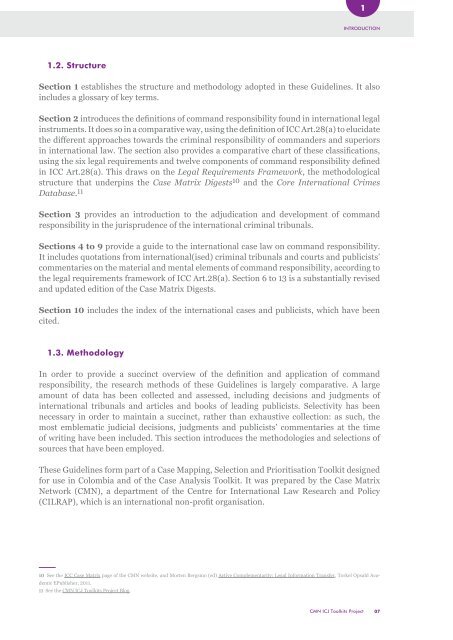Command Responsibility
CMN_ICL_Guidelines_Command_Responsibility_En
CMN_ICL_Guidelines_Command_Responsibility_En
You also want an ePaper? Increase the reach of your titles
YUMPU automatically turns print PDFs into web optimized ePapers that Google loves.
1<br />
INTRODUCTION<br />
1.2. Structure<br />
Section 1 establishes the structure and methodology adopted in these Guidelines. It also<br />
includes a glossary of key terms.<br />
Section 2 introduces the definitions of command responsibility found in international legal<br />
instruments. It does so in a comparative way, using the definition of ICC Art.28(a) to elucidate<br />
the different approaches towards the criminal responsibility of commanders and superiors<br />
in international law. The section also provides a comparative chart of these classifications,<br />
using the six legal requirements and twelve components of command responsibility defined<br />
in ICC Art.28(a). This draws on the Legal Requirements Framework, the methodological<br />
structure that underpins the Case Matrix Digests 10 and the Core International Crimes<br />
Database. 11<br />
Section 3 provides an introduction to the adjudication and development of command<br />
responsibility in the jurisprudence of the international criminal tribunals.<br />
Sections 4 to 9 provide a guide to the international case law on command responsibility.<br />
It includes quotations from international(ised) criminal tribunals and courts and publicists’<br />
commentaries on the material and mental elements of command responsibility, according to<br />
the legal requirements framework of ICC Art.28(a). Section 6 to 13 is a substantially revised<br />
and updated edition of the Case Matrix Digests.<br />
Section 10 includes the index of the international cases and publicists, which have been<br />
cited.<br />
1.3. Methodology<br />
In order to provide a succinct overview of the definition and application of command<br />
responsibility, the research methods of these Guidelines is largely comparative. A large<br />
amount of data has been collected and assessed, including decisions and judgments of<br />
international tribunals and articles and books of leading publicists. Selectivity has been<br />
necessary in order to maintain a succinct, rather than exhaustive collection: as such, the<br />
most emblematic judicial decisions, judgments and publicists’ commentaries at the time<br />
of writing have been included. This section introduces the methodologies and selections of<br />
sources that have been employed.<br />
These Guidelines form part of a Case Mapping, Selection and Prioritisation Toolkit designed<br />
for use in Colombia and of the Case Analysis Toolkit. It was prepared by the Case Matrix<br />
Network (CMN), a department of the Centre for International Law Research and Policy<br />
(CILRAP), which is an international non-profit organisation.<br />
10 See the ICC Case Matrix page of the CMN website, and Morten Bergsmo (ed) Active Complementarity: Legal Information Transfer, Torkel Opsahl Academic<br />
EPublisher, 2011.<br />
11 See the CMN ICJ Toolkits Project Blog.<br />
CMN ICJ Toolkits Project<br />
07


